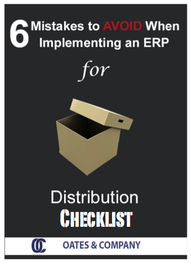Choosing an ERP, as we’ve discussed before, is not an easy undertaking. Previously, a blog entitled “6 Mistakes to Avoid When Implementing an ERP” was published. We’ll now be looking at those six mistakes in further depth.
To recap: Enterprise resource planning (ERP) is a type of business management software that supports the basic internal processes of a company. It allows companies to use an integrated system to manage all the pieces of their operation. Product planning, development, manufacturing processes, inventory control, customer and vendor data, materials management, sales, and marketing are all examples of what an ERP system can control and streamline.
ERP Mistake #2: Not Having Everyone On Board
 The quickest way to doom any project, and especially a project with the magnitude of an ERP implementation, is to keep your employees uninformed. Implementing an ERP system and then using it is far more than just an Information Technology project – it will affect every employee at your company. Failure to prepare your employees can equal failure to successfully implement your ERP software; if your implementation fails, your company has wasted a lot of time and a lot of money.
The quickest way to doom any project, and especially a project with the magnitude of an ERP implementation, is to keep your employees uninformed. Implementing an ERP system and then using it is far more than just an Information Technology project – it will affect every employee at your company. Failure to prepare your employees can equal failure to successfully implement your ERP software; if your implementation fails, your company has wasted a lot of time and a lot of money.
Communication is the key to preventing failure. If you talk to your employees, explain the process to them, and let them know what to expect, you can get them on board. If you talk to them, explain the process to them, and then explain how implementing the software will make their jobs easier and better, you can even get them excited. Being able to explain to your employees how they personally – and the company as a whole – will benefit from the change is a necessity in this transition.
Another important factor in getting all your employees on board with the project is training. People do not like what they do not understand. You can’t make a change as big as implementing an ERP system and fail to give your employees exceptional training – not least of all because if you don’t, you are not harnessing the full potential that having ERP software affords you. Employee training shouldn’t be saved for after the implementation is complete and they suddenly need to do their jobs on a new system, either – employee training should begin before the process even gets off the ground.
Moreover, employee training doesn’t just ensure that employees are happy – it could also prevent a drop in revenue after the system goes live. Giving your employees time to practice on the system and get comfortable with it means that when it does go live, there won’t such a large learning curve, fewer mistakes will be made, and your business will make the transition without any “hiccups” that could cost you money.
Essentially, your employees don't like change because it often means more confusion and ultimately more work. They would prefer to deal with the old system's quirks and inefficiencies – because at least they’re used to them – than adapt to a new system. The best way to keep your employees happy and make your ERP implementation a success at the same time is to provide a positive experience, and that means communication and training.
Contact Oates & Company today – we'll help you get your employees on board.



